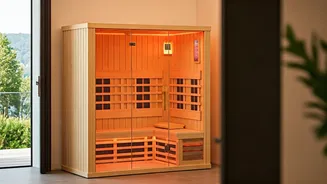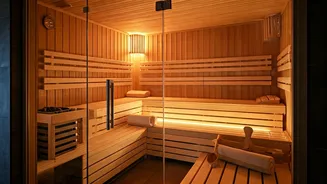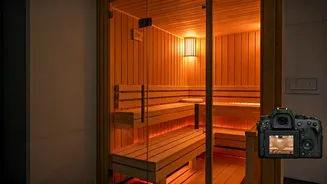Sauna Styles Explored
At-home saunas come in various forms, each with unique characteristics. Traditional saunas, which use heated rocks and water to generate steam, provide
a classic sauna experience. The heat often rises between 150 to 195 degrees Fahrenheit. Infrared saunas are an alternative, employing infrared lamps to directly warm the body rather than the air. These saunas typically operate at a lower temperature, around 120 to 140 degrees Fahrenheit. The construction materials also vary; some are made of cedar or other fragrant woods, which contribute to the overall spa-like ambiance. Consider how much space you have available, your budget, and the type of experience you desire when selecting between these styles. Think about your preferred heat level and any specific health goals you may have, such as detoxification or pain relief, to help guide your decision.
Assessing Space Requirements
Before purchasing an at-home sauna, carefully assess the space available in your home. Saunas come in different sizes, from compact models designed for small bathrooms to larger units that can accommodate several people. Measure the area where you intend to place the sauna, accounting for the sauna's dimensions as well as additional space for ventilation and entry. Some saunas may require dedicated electrical wiring, which could influence your placement options. Ensure that the floor can bear the sauna's weight, especially if you opt for a larger or heavier model. Consider the distance from the power outlets and water sources if you desire to shower or use other facilities near the sauna. Clear any obstructions, such as furniture, to allow for seamless installation and use. Accurate measurements and careful planning are key to ensuring that the sauna fits comfortably and safely within your home environment.
Budgeting for Investment
The cost of an at-home sauna varies significantly depending on the type, size, and features. Traditional saunas may range from a few thousand to over ten thousand rupees, while infrared saunas are often more affordable. In addition to the initial purchase price, factor in installation costs, which might involve hiring a professional for electrical work or assembly. Ongoing expenses include electricity consumption, as saunas use a considerable amount of energy to heat up and maintain temperature. Think about the need for cleaning and maintenance supplies and the cost of any potential repairs or replacements. Budgeting for these additional costs is essential to avoid unexpected expenses. Many retailers offer financing options, so explore these possibilities to manage your investment. It's also helpful to compare prices from various vendors and read reviews to ensure you get the best value for your money.
Maintenance and Upkeep
Maintaining your at-home sauna is important to ensure its longevity and hygiene. Regularly clean the interior surfaces, including the benches, walls, and floor, using a mild, non-toxic cleaner. For traditional saunas, regularly inspect and clean the rocks, and replace them when they show signs of wear. Proper ventilation is essential to prevent mold and mildew growth. Ensure the area around the sauna is dry after each use. Check and maintain the electrical components, such as the heating element and control panel, as needed. Consider scheduling professional maintenance every year to address any complex issues and ensure safe operation. Adhering to these maintenance practices will help prolong the life of your sauna, keeping it clean, safe, and ready for your next relaxation session. Regularly cleaning and maintaining your sauna will provide a healthier experience.
Maximizing Your Sauna
To fully enjoy the benefits of your at-home sauna, consider these tips. Before entering the sauna, shower to cleanse your skin and remove any lotions or oils. Hydrate well by drinking plenty of water before, during, and after your sauna session. Limit your time in the sauna, typically starting with 10-15 minutes and gradually increasing as your body adjusts. Avoid alcohol and heavy meals before your sauna session. Once inside, sit or lie comfortably, and relax. Listen to calming music, read a book, or practice meditation to enhance your experience. After your session, cool down gradually, by taking a shower and resting to allow your body to adjust. Regular sauna use can provide physical and mental health advantages; however, consult with your doctor if you have any health conditions or concerns before beginning a regular sauna routine.










